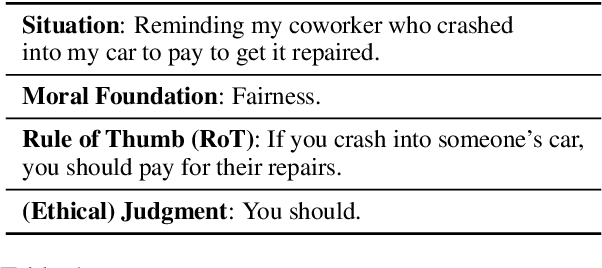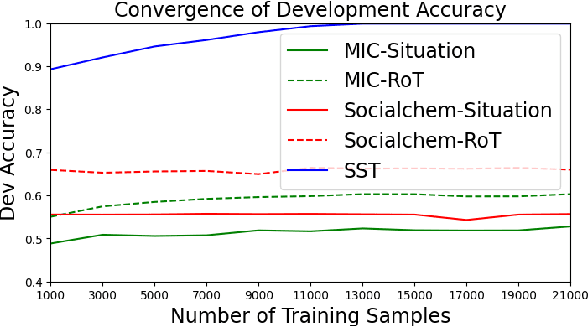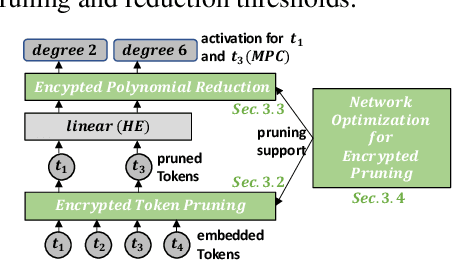Lei Jiang
Emotion Transfer with Enhanced Prototype for Unseen Emotion Recognition in Conversation
Aug 27, 2025Abstract:Current Emotion Recognition in Conversation (ERC) research follows a closed-domain assumption. However, there is no clear consensus on emotion classification in psychology, which presents a challenge for models when it comes to recognizing previously unseen emotions in real-world applications. To bridge this gap, we introduce the Unseen Emotion Recognition in Conversation (UERC) task for the first time and propose ProEmoTrans, a solid prototype-based emotion transfer framework. This prototype-based approach shows promise but still faces key challenges: First, implicit expressions complicate emotion definition, which we address by proposing an LLM-enhanced description approach. Second, utterance encoding in long conversations is difficult, which we tackle with a proposed parameter-free mechanism for efficient encoding and overfitting prevention. Finally, the Markovian flow nature of emotions is hard to transfer, which we address with an improved Attention Viterbi Decoding (AVD) method to transfer seen emotion transitions to unseen emotions. Extensive experiments on three datasets show that our method serves as a strong baseline for preliminary exploration in this new area.
Sig-DEG for Distillation: Making Diffusion Models Faster and Lighter
Aug 23, 2025Abstract:Diffusion models have achieved state-of-the-art results in generative modelling but remain computationally intensive at inference time, often requiring thousands of discretization steps. To this end, we propose Sig-DEG (Signature-based Differential Equation Generator), a novel generator for distilling pre-trained diffusion models, which can universally approximate the backward diffusion process at a coarse temporal resolution. Inspired by high-order approximations of stochastic differential equations (SDEs), Sig-DEG leverages partial signatures to efficiently summarize Brownian motion over sub-intervals and adopts a recurrent structure to enable accurate global approximation of the SDE solution. Distillation is formulated as a supervised learning task, where Sig-DEG is trained to match the outputs of a fine-resolution diffusion model on a coarse time grid. During inference, Sig-DEG enables fast generation, as the partial signature terms can be simulated exactly without requiring fine-grained Brownian paths. Experiments demonstrate that Sig-DEG achieves competitive generation quality while reducing the number of inference steps by an order of magnitude. Our results highlight the effectiveness of signature-based approximations for efficient generative modeling.
Dialogues Aspect-based Sentiment Quadruple Extraction via Structural Entropy Minimization Partitioning
Aug 07, 2025Abstract:Dialogues Aspect-based Sentiment Quadruple Extraction (DiaASQ) aims to extract all target-aspect-opinion-sentiment quadruples from a given multi-round, multi-participant dialogue. Existing methods typically learn word relations across entire dialogues, assuming a uniform distribution of sentiment elements. However, we find that dialogues often contain multiple semantically independent sub-dialogues without clear dependencies between them. Therefore, learning word relationships across the entire dialogue inevitably introduces additional noise into the extraction process. To address this, our method focuses on partitioning dialogues into semantically independent sub-dialogues. Achieving completeness while minimizing these sub-dialogues presents a significant challenge. Simply partitioning based on reply relationships is ineffective. Instead, we propose utilizing a structural entropy minimization algorithm to partition the dialogues. This approach aims to preserve relevant utterances while distinguishing irrelevant ones as much as possible. Furthermore, we introduce a two-step framework for quadruple extraction: first extracting individual sentiment elements at the utterance level, then matching quadruples at the sub-dialogue level. Extensive experiments demonstrate that our approach achieves state-of-the-art performance in DiaASQ with much lower computational costs.
Eyepiece-free pupil-optimized holographic near-eye displays
Jul 30, 2025Abstract:Computer-generated holography (CGH) represents a transformative visualization approach for next-generation immersive virtual and augmented reality (VR/AR) displays, enabling precise wavefront modulation and naturally providing comprehensive physiological depth cues without the need for bulky optical assemblies. Despite significant advancements in computational algorithms enhancing image quality and achieving real-time generation, practical implementations of holographic near-eye displays (NEDs) continue to face substantial challenges arising from finite and dynamically varying pupil apertures, which degrade image quality and compromise user experience. In this study, we introduce an eyepiece-free pupil-optimized holographic NED. Our proposed method employs a customized spherical phase modulation strategy to generate multiple viewpoints within the pupil, entirely eliminating the dependence on conventional optical eyepieces. Through the joint optimization of amplitude and phase distributions across these viewpoints, the method markedly mitigates image degradation due to finite pupil sampling and resolves inapparent depth cues induced by the spherical phase. The demonstrated method signifies a substantial advancement toward the realization of compact, lightweight, and flexible holographic NED systems, fulfilling stringent requirements for future VR/AR display technologies.
RECALLED: An Unbounded Resource Consumption Attack on Large Vision-Language Models
Jul 24, 2025Abstract:Resource Consumption Attacks (RCAs) have emerged as a significant threat to the deployment of Large Language Models (LLMs). With the integration of vision modalities, additional attack vectors exacerbate the risk of RCAs in large vision-language models (LVLMs). However, existing red-teaming studies have largely overlooked visual inputs as a potential attack surface, resulting in insufficient mitigation strategies against RCAs in LVLMs. To address this gap, we propose RECALLED (\textbf{RE}source \textbf{C}onsumption \textbf{A}ttack on \textbf{L}arge Vision-\textbf{L}anguag\textbf{E} Mo\textbf{D}els), the first approach for exploiting visual modalities to trigger unbounded RCAs red-teaming. First, we present \textit{Vision Guided Optimization}, a fine-grained pixel-level optimization, to obtain \textit{Output Recall} adversarial perturbations, which can induce repeating output. Then, we inject the perturbations into visual inputs, triggering unbounded generations to achieve the goal of RCAs. Additionally, we introduce \textit{Multi-Objective Parallel Losses} to generate universal attack templates and resolve optimization conflicts when intending to implement parallel attacks. Empirical results demonstrate that RECALLED increases service response latency by over 26 $\uparrow$, resulting in an additional 20\% increase in GPU utilization and memory consumption. Our study exposes security vulnerabilities in LVLMs and establishes a red-teaming framework that can facilitate future defense development against RCAs.
T-T: Table Transformer for Tagging-based Aspect Sentiment Triplet Extraction
May 08, 2025Abstract:Aspect sentiment triplet extraction (ASTE) aims to extract triplets composed of aspect terms, opinion terms, and sentiment polarities from given sentences. The table tagging method is a popular approach to addressing this task, which encodes a sentence into a 2-dimensional table, allowing for the tagging of relations between any two words. Previous efforts have focused on designing various downstream relation learning modules to better capture interactions between tokens in the table, revealing that a stronger capability to capture relations can lead to greater improvements in the model. Motivated by this, we attempt to directly utilize transformer layers as downstream relation learning modules. Due to the powerful semantic modeling capability of transformers, it is foreseeable that this will lead to excellent improvement. However, owing to the quadratic relation between the length of the table and the length of the input sentence sequence, using transformers directly faces two challenges: overly long table sequences and unfair local attention interaction. To address these challenges, we propose a novel Table-Transformer (T-T) for the tagging-based ASTE method. Specifically, we introduce a stripe attention mechanism with a loop-shift strategy to tackle these challenges. The former modifies the global attention mechanism to only attend to a 2-dimensional local attention window, while the latter facilitates interaction between different attention windows. Extensive and comprehensive experiments demonstrate that the T-T, as a downstream relation learning module, achieves state-of-the-art performance with lower computational costs.
Addressing Noise and Stochasticity in Fraud Detection for Service Networks
May 02, 2025Abstract:Fraud detection is crucial in social service networks to maintain user trust and improve service network security. Existing spectral graph-based methods address this challenge by leveraging different graph filters to capture signals with different frequencies in service networks. However, most graph filter-based methods struggle with deriving clean and discriminative graph signals. On the one hand, they overlook the noise in the information propagation process, resulting in degradation of filtering ability. On the other hand, they fail to discriminate the frequency-specific characteristics of graph signals, leading to distortion of signals fusion. To address these issues, we develop a novel spectral graph network based on information bottleneck theory (SGNN-IB) for fraud detection in service networks. SGNN-IB splits the original graph into homophilic and heterophilic subgraphs to better capture the signals at different frequencies. For the first limitation, SGNN-IB applies information bottleneck theory to extract key characteristics of encoded representations. For the second limitation, SGNN-IB introduces prototype learning to implement signal fusion, preserving the frequency-specific characteristics of signals. Extensive experiments on three real-world datasets demonstrate that SGNN-IB outperforms state-of-the-art fraud detection methods.
TARAC: Mitigating Hallucination in LVLMs via Temporal Attention Real-time Accumulative Connection
Apr 05, 2025



Abstract:Large Vision-Language Models have demonstrated remarkable performance across various tasks; however, the challenge of hallucinations constrains their practical applications. The hallucination problem arises from multiple factors, including the inherent hallucinations in language models, the limitations of visual encoders in perception, and biases introduced by multimodal data. Extensive research has explored ways to mitigate hallucinations. For instance, OPERA prevents the model from overly focusing on "anchor tokens", thereby reducing hallucinations, whereas VCD mitigates hallucinations by employing a contrastive decoding approach. In this paper, we investigate the correlation between the decay of attention to image tokens and the occurrence of hallucinations. Based on this finding, we propose Temporal Attention Real-time Accumulative Connection (TARAC), a novel training-free method that dynamically accumulates and updates LVLMs' attention on image tokens during generation. By enhancing the model's attention to image tokens, TARAC mitigates hallucinations caused by the decay of attention on image tokens. We validate the effectiveness of TARAC across multiple models and datasets, demonstrating that our approach substantially mitigates hallucinations. In particular, TARAC reduces $C_S$ by 25.2 and $C_I$ by 8.7 compared to VCD on the CHAIR benchmark.
Revealing the Pragmatic Dilemma for Moral Reasoning Acquisition in Language Models
Feb 25, 2025



Abstract:Ensuring that Large Language Models (LLMs) return just responses which adhere to societal values is crucial for their broader application. Prior research has shown that LLMs often fail to perform satisfactorily on tasks requiring moral cognizance, such as ethics-based judgments. While current approaches have focused on fine-tuning LLMs with curated datasets to improve their capabilities on such tasks, choosing the optimal learning paradigm to enhance the ethical responses of LLMs remains an open research debate. In this work, we aim to address this fundamental question: can current learning paradigms enable LLMs to acquire sufficient moral reasoning capabilities? Drawing from distributional semantics theory and the pragmatic nature of moral discourse, our analysis indicates that performance improvements follow a mechanism similar to that of semantic-level tasks, and therefore remain affected by the pragmatic nature of morals latent in discourse, a phenomenon we name the pragmatic dilemma. We conclude that this pragmatic dilemma imposes significant limitations on the generalization ability of current learning paradigms, making it the primary bottleneck for moral reasoning acquisition in LLMs.
CipherPrune: Efficient and Scalable Private Transformer Inference
Feb 24, 2025



Abstract:Private Transformer inference using cryptographic protocols offers promising solutions for privacy-preserving machine learning; however, it still faces significant runtime overhead (efficiency issues) and challenges in handling long-token inputs (scalability issues). We observe that the Transformer's operational complexity scales quadratically with the number of input tokens, making it essential to reduce the input token length. Notably, each token varies in importance, and many inputs contain redundant tokens. Additionally, prior private inference methods that rely on high-degree polynomial approximations for non-linear activations are computationally expensive. Therefore, reducing the polynomial degree for less important tokens can significantly accelerate private inference. Building on these observations, we propose \textit{CipherPrune}, an efficient and scalable private inference framework that includes a secure encrypted token pruning protocol, a polynomial reduction protocol, and corresponding Transformer network optimizations. At the protocol level, encrypted token pruning adaptively removes unimportant tokens from encrypted inputs in a progressive, layer-wise manner. Additionally, encrypted polynomial reduction assigns lower-degree polynomials to less important tokens after pruning, enhancing efficiency without decryption. At the network level, we introduce protocol-aware network optimization via a gradient-based search to maximize pruning thresholds and polynomial reduction conditions while maintaining the desired accuracy. Our experiments demonstrate that CipherPrune reduces the execution overhead of private Transformer inference by approximately $6.1\times$ for 128-token inputs and $10.6\times$ for 512-token inputs, compared to previous methods, with only a marginal drop in accuracy. The code is publicly available at https://github.com/UCF-Lou-Lab-PET/cipher-prune-inference.
 Add to Chrome
Add to Chrome Add to Firefox
Add to Firefox Add to Edge
Add to Edge